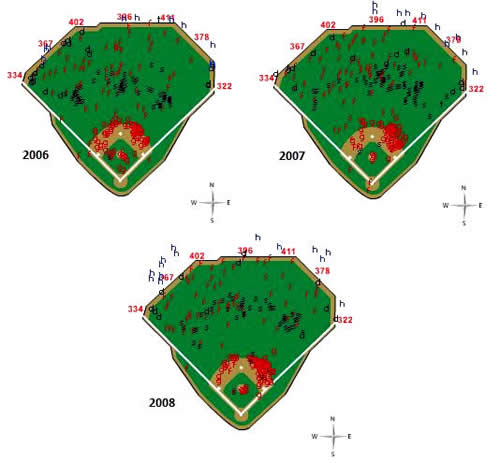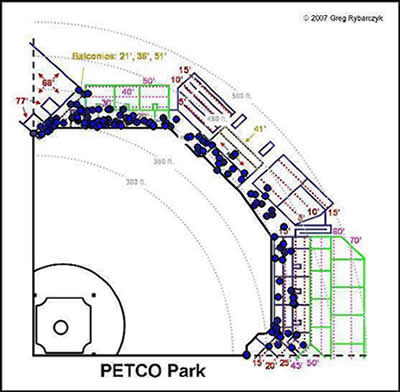BP Comment Quick Links

 | |
March 30, 2009 Fantasy BeatTo the Warning Track
Last week we took a look at how the wind and his home park affected Kevin Youkilis' home-run production in 2008. Youkilis is an example of a player who is being overrated due to some homers receiving a boost from those factors, but it can work both ways; there are also players who are underrated due to these same effects holding their power numbers down, and this time out we'll take a look at one of them. Adrian Gonzalez has quietly been one of the better hitters in the game the past few seasons as he toils away in the pitcher's heaven of Petco Park. Last year he compiled 45.8 VORP, his second year in a row with at least four wins above replacement level with his bat, by hitting .279/.361/.510. While that line may not seem like very much without any adjustments-his OPS of 871 tied him for 40th among qualified hitters-it's far more impressive once you take his playing in Petco into account. His equivalent line of .298/.378/.554 is much more eye-catching, and were it his actual rather than his adjusted line, he would have ranked 13th on the OPS leader boards. I'm not using OPS as a gauge of how valuable Gonzalez actually is, but it is interesting to see how much of an improvement there is in his line simply by taking Petco out of the equation. His .311 EqA last year suggests that he was one of the 10 best hitters in the National League, but if you were to ask someone to compile a quick list of just who those players are, chances are he'd be skipped over-you simply don't hear his name mentioned along with those of Albert Pujols, Chipper Jones, Hanley Ramirez, David Wright, Lance Berkman, or Matt Holliday very often (though teammate Brian Giles, in his quest to be perpetually underrated while also toiling in Petco, actually ranked ahead of Gonzalez last year in EqA thanks to his fantastic walk rates and decent power). Let's take a look at the difference between Gonzalez' performance at home and on the road during his three years as a Padre:
Home Road
Year AVG/ OBP/ SLG ISO AVG/ OBP/ SLG ISO
2006 .296/.344/.471 .175 .311/.378/.527 .216
2007 .266/.335/.424 .158 .295/.358/.570 .276
2008 .247/.355/.433 .186 .308/.368/.578 .270
Total .269/.345/.442 .173 .304/.367/.560 .256
We're talking about two completely different players here. The home line looks like something you might expect from Adrian Beltre or James Loney, while the line from away games looks like a more powerful version of Josh Hamilton, or Lance Berkman with far fewer walks. It's well known that Petco hinders power and hitting overall, but the extremes to which it punishes Gonzalez are somewhat mind-boggling. Let's take a look at the specifics of Petco regarding Gonzalez' power production, courtesy of the Hit Charts at MLB.com:
 Gonzalez had power to all fields in 2006, but it wasn't extreme power; his homers barely cleared the wall at Petco, and just 10 of his 24 long balls came at home. In 2007, Gonzalez failed to hit a single home run over the wall in left field, instead picking up a few doubles and loads of long, fly-ball outs. Again, 10 of his home runs came at Petco, but this time it was 10 of 30. Lastly, we have 2008, when Gonzalez seemed to realize that hitting fly balls for normal distance just wasn't going to cut it; he hit eight homers over the wall in left, with all but one of those qualifying as deep shots for Petco. He also had a handful of warning-track shots that probably would have gone out in many other parks, as well as a few doubles along the warning track. Just 14 of his 36 home runs came at Petco, but you can see that this number should have been higher; I'm counting nine warning-track shots, and if you assume that half of those should have been home runs, then Major League Baseball should have had three 40-homer guys last season. Looking at his complete homer data from Hit Tracker, we see that Gonzalez wasn't very lucky with his home runs in '08, and that he has legitimate power. He had one homer off of Alex Hinshaw on June 1 at San Francisco that would not have left any other stadium, and another off of Logan Kensing on May 3 at Florida that would have left eight of them, but 30 of his homers would have been gone in at least 22 of the 30 parks in the majors. Hit Tracker uses two distances for home runs, "True" and "Standard." We're going to use Standard Distance here, for reasons you'll understand from its glossary entry: The estimated distance in feet the home run would have traveled if it flew uninterrupted all the way down to field level, and if the home run had been hit with no wind, in 70-degree air at sea level. Standard distance factors out the influence of wind, temperature, and altitude, and is thus the best way of comparing home runs hit under a variety of different conditions. The average standard distance of Gonzalez's Petco home runs was 392.4 feet, while the average standard distance of all of his other homers was 392.2 feet. There's a large discrepancy in the rate at which he hits homers, despite hitting the ball the same adjusted distance both at home and away. As for the "True" distance, which is how far the ball actually travelled (though estimated for distance if the ball's flight was interrupted prior to reaching field level), Gonzalez averaged 402 feet on the road, and just 390 feet at Petco. He does have Coors to contend with however, which does increase the average distance-take out the three he hit at Coors, and his True Distance average becomes 395 feet. I'm not sure that I'm comfortable with removing Coors from the equation entirely, but even if we do, there's a discrepancy between the average distances that's still significant-think back to those warning-track shots that just missed. If you look at all of the home runs hit at Petco last season, we see that the average Standard distance is lower than the True distance by 1.3 feet; players actually got a tiny boost from the wind and temperature, though as you can plainly see in the overall results, the dimensions of the park override that teeny bump. Hit Tracker accounts only for the balls that actually became home runs, so it's difficult to gauge just how adverse of an effect the dimensions have on the totals, but we can take a look at a scatter-plot to get some idea:
 There aren't a lot of balls that cross the wall and keep on going at Petco, probably because the dimensions in left and right-center field are extremely deep, while left and right field also sit far back except for in the very corners of fair territory. Now picture Gonzalez' warning-track outs and doubles, and think about how just another five to ten feet could have converted a few of those into home runs, bringing him closer to a balanced home/road split. It's funny that Gonzalez was once with the Texas Rangers in a park that last year saw 2.5 home runs per game and 204 on the season. The average True Distance there is 405.1 feet, 8.8 feet further than the average Standard Distance; the temperature, wind, and altitude all transform Arlington into the American League's version of Coors Field. If he'd not been traded along with Chris Young a few years ago, it might have been Gonzalez who was the focus of the previous piece on overrated power hitters using their home park to advantage, rather than today's, as one of the more underrated bats in the game. You're not going to take Adrian Gonzalez in an earlier round in your draft because of this, but the information does provide an important lesson on how much factors like park dimensions can affect a player's performance. Kevin Youkilis and Carlos Quentin were both lucky last year, in the sense that their home parks boosted their production considerably, but both of those players are still there in 2009, and you should use that knowledge to your advantage on draft day. Conversely, if both of them were to be traded to a team like San Diego with our friend Gonzalez, or to Oakland as Matt Holliday was this winter, it's important not just to know by how much, but also why your expectations for them should be lowered. Knowing more about park dimensions will help you to figure out that Raul Ibanez' moving from a pitcher's park in Seattle to a hitter's park in Philadelphia may not be as big of a deal as you think, or on the pitching side of things, that someone like Kyle Lohse has added value due to his pitching in a place that deflates home runs, which have been his one major stumbling block as a pitcher. You're beginning to see new statistical terms that you never expected would enter into the mainstream lexicon, leveling the playing field and hurting those owners who were ahead of the curve just a few years ago. The same thing is happening in real baseball, as the market inefficiencies discussed in Moneyball are generally accepted now, and teams keep moving on to more advanced information (such as Pitch F/X, or video scouting) in order to find an edge. There's no reason you can't employ some of that on the fantasy level in order to once again move ahead of the curve.
|
I can't help but feel bad for Adrian. What kind of numbers would be put up in a hitter friendly park?